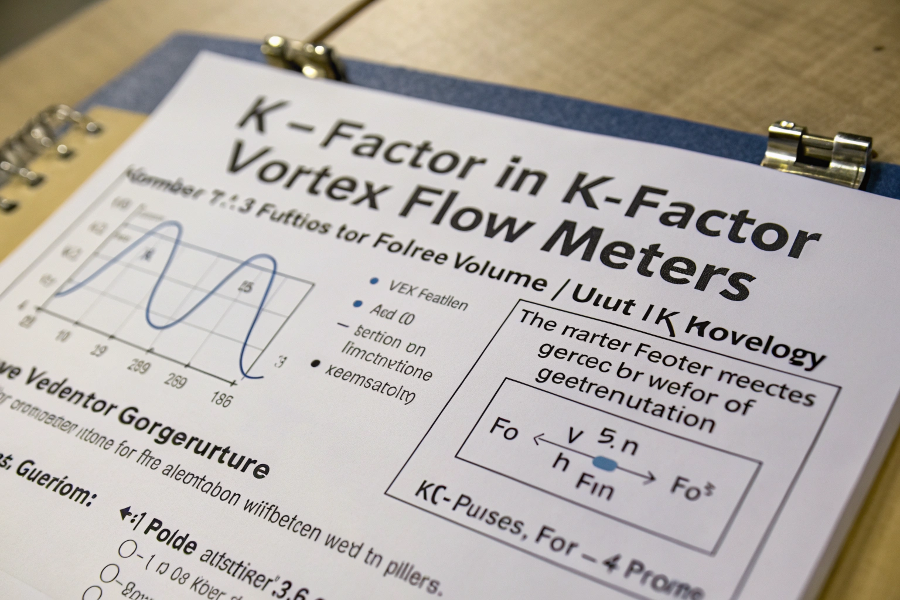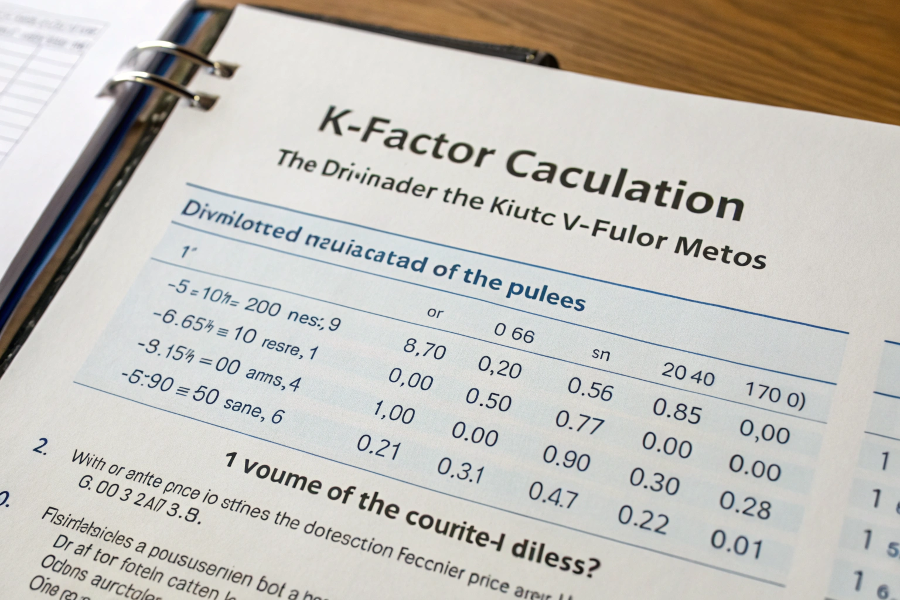Calculating K-factor wrongly can lead to significant measurement errors and costly process control issues.
The K-factor in vortex flow meters represents the number of pulses generated per unit volume of fluid flow, typically expressed as pulses/m³ or pulses/gallon.

K-Factor Calculation Diagram
Let me share my experience with K-factor calculations and calibrations from numerous field installations.
What Is The K-Factor In Calibration?
Calibration accuracy directly impacts flow measurement reliability and process control.
The calibration K-factor represents the meter’s response characteristic, serving as a conversion factor between pulse output and actual flow volume.
 Flow Meter Calibration Setup
Flow Meter Calibration Setup
Based on my calibration experience:
Calibration Process
-
Setup Requirements
Component Purpose Specification Reference Standard Accuracy basis ±0.1% or better Test Equipment Flow generation Stable flow source Data System Recording High resolution Temperature Control Stability ±1°C variation -
Testing Protocol
- Multiple flow points
- Repeatability checks
- Linearity verification
- Uncertainty calculation
Quality Assurance
-
Documentation
- Raw data records
- Calculation sheets
- Uncertainty analysis
- Traceability information
-
Verification Steps
- Standard comparison
- Historical review
- Performance trending
- Acceptance criteria
How To Calculate K-Factor For Vortex Flow Meter?
Many engineers struggle with determining accurate K-factors for their specific applications.
K-factor is calculated by dividing the number of pulses counted during calibration by the actual volume of fluid that passed through the meter during that period.

K-Factor Calculation Method
From my calibration experience:
Calculation Process
-
Basic Formula Components
Parameter Unit Description Pulse Count Pulses Total pulses during test Volume m³ or gallons Measured fluid volume Time seconds Test duration Flow Rate m³/h or GPM Average flow rate -
Calculation Steps
- Collect pulse data
- Measure actual volume
- Calculate ratio
- Apply correction factors
- Verify results
Influencing Factors
-
Process Variables
- Fluid properties
- Temperature effects
- Pressure conditions
- Reynolds number
-
Equipment Considerations
- Meter size
- Installation effects
- Signal processing
- Electronic resolution
How Is The K-Factor Calculated?
Understanding the mathematics behind K-factor calculation ensures accurate flow measurement.
The K-factor calculation involves dividing the total number of pulses by the actual volume, then applying correction factors for temperature, pressure, and fluid properties.

K-Factor Calculation Factors
Drawing from my technical expertise:
Mathematical Approach
-
Basic Equation
Step Formula Variables Raw K-factor K = P/V P=pulses, V=volume Temperature correction Kt = K × (1 + αΔT) α=temp coefficient Pressure correction Kp = Kt × (1 + βΔP) β=pressure coefficient Final K-factor Kf = Kp × Cf Cf=correction factor -
Correction Factors
- Material expansion
- Fluid density changes
- Reynolds number effects
- Installation effects
Practical Implementation
- Calibration Requirements
- Standard conditions
- Reference equipment
- Data collection
- Uncertainty analysis
What Is The K-Factor In An Energy Meter?
Energy meters require special consideration for K-factor calculations to ensure accurate energy consumption measurement.
In energy meters, the K-factor combines flow measurement with temperature differential and specific heat capacity to calculate energy transfer rates.
From my energy measurement experience:
Energy Calculation Components
-
Measurement Parameters
Parameter Unit Purpose Flow Rate m³/h Volume measurement Temperature Δ °C Energy transfer Specific Heat kJ/kg°C Energy content Density kg/m³ Mass calculation -
Integration Factors
- Time base conversion
- Units conversion
- Density compensation
- Temperature effects
System Implementation
-
Configuration Requirements
- Parameter setup
- Units selection
- Range settings
- Alarm limits
-
Operational Considerations
- Regular verification
- Calibration intervals
- Data logging
- Performance monitoring
Conclusion
Accurate K-factor calculation and calibration are essential for reliable flow measurement, requiring careful consideration of process conditions and proper calibration procedures.
